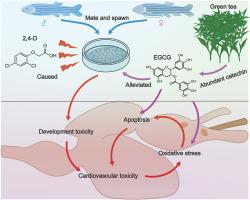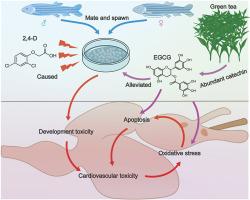EGCG alleviated 2,4-D-induced cardiovascular toxicity in zebrafish embryos via Nrf2 and p53 pathways
IF 7.3
2区 环境科学与生态学
Q1 ENVIRONMENTAL SCIENCES
引用次数: 0
Abstract
2,4-Dichlorophenoxyacetic acid (2,4-D), a widely used herbicide in cultivation, exhibits strong cardiotoxicity to living organisms, thus shows high risks to human health. Epigallocatechin gallate (EGCG), a type of catechin largely found in tea, is well-known for its antioxidant, antiapoptotic, and cardiovascular protective properties. Neverthless, the potential protective effects of EGCG against 2,4-D-induced cardiotoxicity remain underexplored to date. In this study, zebrafish embryos were exposed to 50 mg/L 2,4-D supplemented with 2 μM EGCG until 96 h post-fertilization (hpf) and the morphology observation, biochemical assays, and gene expression analyses were applied to evaluate the role of EGCG against 2,4-D toxicity. The results showed that EGCG significantly restored the 2,4-D-induced cardiovascular impairments including pericardial edema, and abnormal heart structure, heart rate and erythropenia. Q-PCR analysis revealed that EGCG markedly reversed the 2,4-D-dysregulated key cardiac development genes nkx2.5, vegf, vmhc, amhc, hand2 and gata4, except for tbx2b, which remained unchanged. EGCG also counteracted 2,4-D-induced oxidative stress by elevating antioxidant enzymes activities and nonenzyme antioxidant content, resulting in the reduction of malondialdehyde (MDA) and reactive oxygen species (ROS) in 2,4-D group. Furthermore, EGCG modulated the expression of antioxidant defense-related genes Nrf2, sod1, cat, gpx1a and gstm and mitigated the harsh effects of 2,4-D. Moreover, EGCG effectively inhibited 2,4-D-stimulated cellular apoptosis through down-regulation of pro-apoptotic genes of p53, caspase-9, caspase-3 and bax and up-regulation of anti-apoptotic gene bcl-2. In conclusion, EGCG can alleviate 2,4-D-induced cardiovascular toxicity in zebrafish embryos through the nrf2-regulated antioxidant pathway and p53-regulated apoptotic pathway.


EGCG通过Nrf2和p53通路减轻2,4- d诱导的斑马鱼胚胎心血管毒性
2,4-二氯苯氧乙酸(2,4- d)是一种广泛应用于栽培的除草剂,对生物具有很强的心脏毒性,对人体健康具有很高的风险。表没食子儿茶素没食子酸酯(EGCG)是一种主要存在于茶叶中的儿茶素,以其抗氧化、抗细胞凋亡和心血管保护特性而闻名。尽管如此,迄今为止,EGCG对2,4- d诱导的心脏毒性的潜在保护作用仍未得到充分探讨。本研究将斑马鱼胚胎暴露于50 mg/L的2,4- d中,并添加2 μM的EGCG,直至受精后96 h (hpf),通过形态学观察、生化分析和基因表达分析来评价EGCG对2,4- d毒性的作用。结果显示,EGCG能显著恢复2,4- d诱导的心包水肿、心脏结构异常、心率异常和红细胞减少等心血管损伤。Q-PCR分析显示,EGCG显著逆转2,4- d失调的关键心脏发育基因nkx2.5、vegf、vmhc、amhc、hand2和gata4,但tbx2b保持不变。EGCG还通过提高抗氧化酶活性和非酶抗氧化剂含量来抵消2,4- d诱导的氧化应激,导致2,4- d组丙二醛(MDA)和活性氧(ROS)的减少。此外,EGCG调节抗氧化防御相关基因Nrf2、sod1、cat、gpx1a和gstm的表达,减轻2,4- d的严重影响。此外,EGCG通过下调促凋亡基因p53、caspase-9、caspase-3和bax,上调抗凋亡基因bcl-2,有效抑制2,4- d刺激的细胞凋亡。综上所述,EGCG可通过nrf2调控的抗氧化途径和p53调控的凋亡途径减轻2,4- d诱导的斑马鱼胚胎心血管毒性。
本文章由计算机程序翻译,如有差异,请以英文原文为准。
求助全文
约1分钟内获得全文
求助全文
来源期刊

Environmental Pollution
环境科学-环境科学
CiteScore
16.00
自引率
6.70%
发文量
2082
审稿时长
2.9 months
期刊介绍:
Environmental Pollution is an international peer-reviewed journal that publishes high-quality research papers and review articles covering all aspects of environmental pollution and its impacts on ecosystems and human health.
Subject areas include, but are not limited to:
• Sources and occurrences of pollutants that are clearly defined and measured in environmental compartments, food and food-related items, and human bodies;
• Interlinks between contaminant exposure and biological, ecological, and human health effects, including those of climate change;
• Contaminants of emerging concerns (including but not limited to antibiotic resistant microorganisms or genes, microplastics/nanoplastics, electronic wastes, light, and noise) and/or their biological, ecological, or human health effects;
• Laboratory and field studies on the remediation/mitigation of environmental pollution via new techniques and with clear links to biological, ecological, or human health effects;
• Modeling of pollution processes, patterns, or trends that is of clear environmental and/or human health interest;
• New techniques that measure and examine environmental occurrences, transport, behavior, and effects of pollutants within the environment or the laboratory, provided that they can be clearly used to address problems within regional or global environmental compartments.
 求助内容:
求助内容: 应助结果提醒方式:
应助结果提醒方式:


